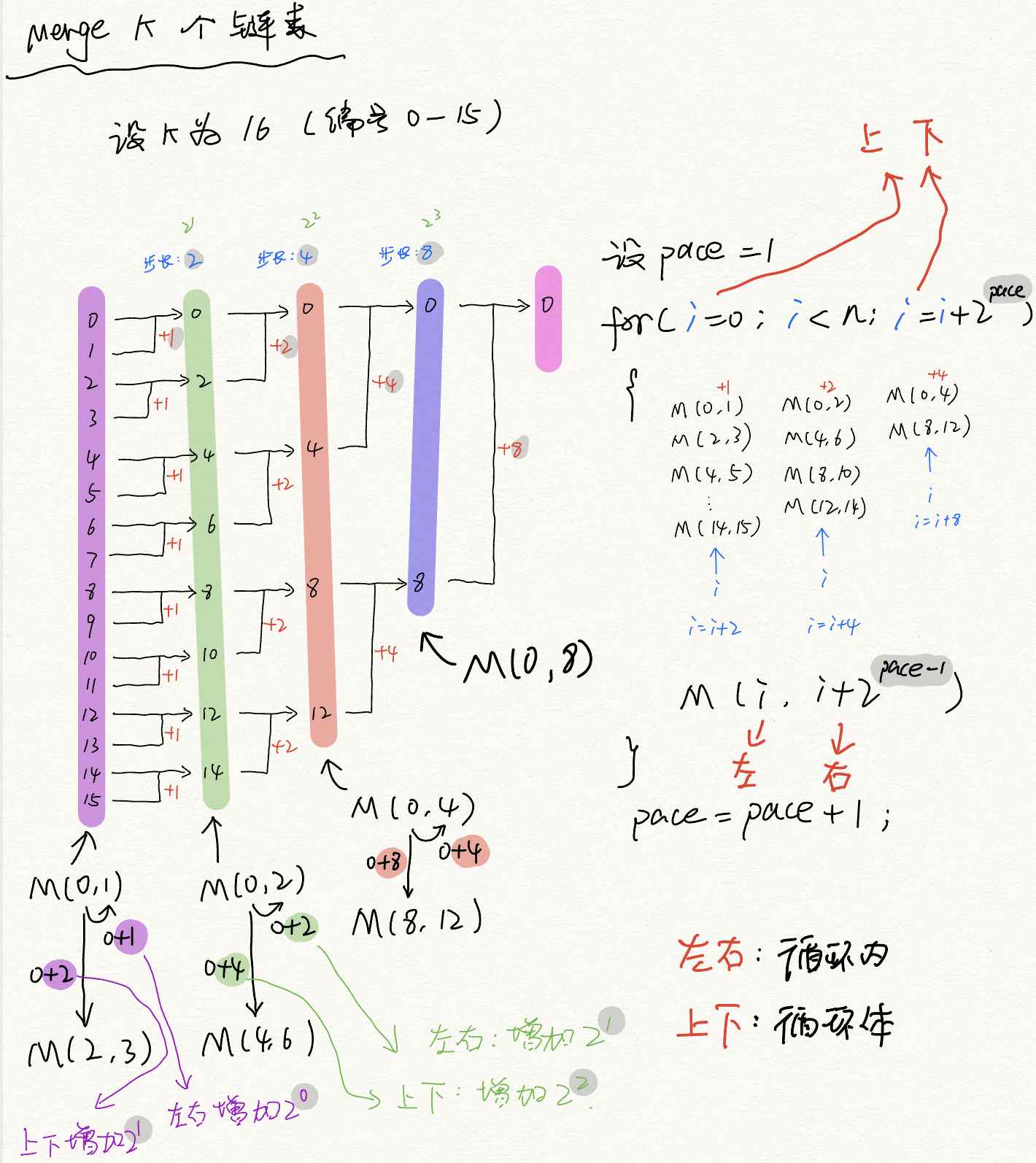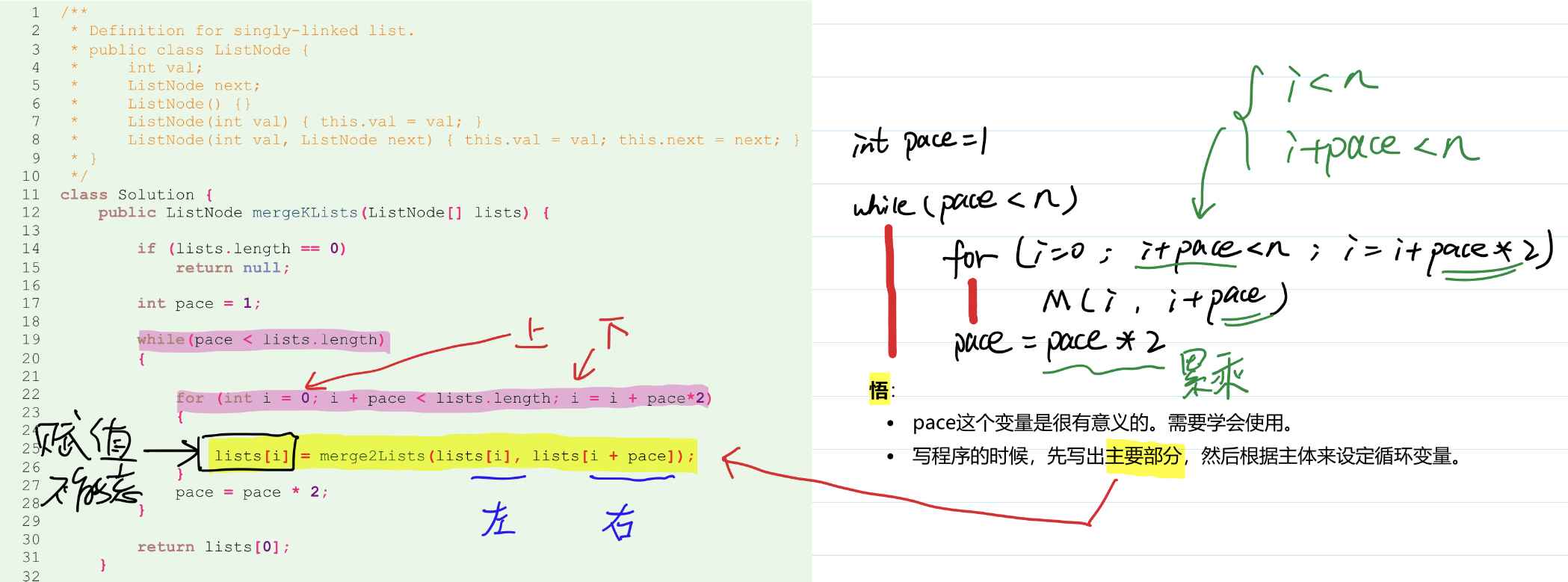[Coding015] LeetCode 23
Merge k Sorted Lists
Get the knowledge flowing and circulating! :)
目录
※ 本题收获
2的幂次是一个很有意思、且值得深入研究的一个问题。
pace = 1;i = i + pace * 2;[i, i + pace]pace = pace * 2;
题目:23. Merge k Sorted Lists
You are given an array of k linked-lists lists, each linked-list is sorted in ascending order.
Merge all the linked-lists into one sorted linked-list and return it.
Example 1:
xxxxxxxxxx101Input: lists = [[1,4,5],[1,3,4],[2,6]]2Output: [1,1,2,3,4,4,5,6]3Explanation: The linked-lists are:4[51->4->5,61->3->4,72->68]9merging them into one sorted list:101->1->2->3->4->4->5->6
Example 2:
xxxxxxxxxx21Input: lists = []2Output: []
Example 3:
xxxxxxxxxx21Input: lists = [[]]2Output: []
Constraints:
k == lists.length0 <= k <= 1040 <= lists[i].length <= 500-104 <= lists[i][j] <= 104lists[i]is sorted in ascending order.The sum of
lists[i].lengthwill not exceed104.
代码1(配 · 手绘过程图)


xxxxxxxxxx321class Solution {2 3 public ListNode mergeTwoLists(ListNode list1, ListNode list2) {4 ...5 }6
7 public ListNode mergeKLists(ListNode[] lists) {8
9 int n = lists.length;10 if (n == 0) return null;11
12 int pace = 1;13
14 while (pace < n)15 {16 // 上:i = 0;17 // 下:i = i + pace * 218 19 // 注意 i + pace < n; 20 // 注意 i = i + pace * 221 for (int i = 0; i + pace < n; i = i + pace * 2) 22 {23 // 左边: list[i]24 // 右边: list[i + pace]25 lists[i] = mergeTwoLists(lists[i], lists[i + pace]); // i + pace26 }27 pace = pace * 2; // 累乘28 }29
30 return lists[0];31 }32}代码解读
本题有两个弯弯绕的地方:
❶ 每次循环的时候,循环体本身的i是如何变化的? 循环体内部的i又有什么作用?
循环体内,(
MergeTwoLists简写为M),每次合并的对象M(i, i + xx);循环体,
for (i = 0; i ... ; i = i + yy)❷ pace的变化,是如何实现2路、4路、8路归并的?
复杂度分析
while循环的时间复杂度(Time complexity):
, is the number of linked lists. for循环内,就是把所有链表中的numbers整合在一起,如果所有numbers的数量是
,那么for循环的时间复杂度是 所以,合并起来是:
附:功能代码(合并两个有序链表)
xxxxxxxxxx451public ListNode mergeTwoLists(ListNode list1, ListNode list2) {2 // 基本情况的判定3 if (list1 == null && list2 == null) return null;4 if (list1 == null) return list2;5 if (list2 == null) return list1;6
7 // 结果链表,最后返回的是:dummy.next; (经典操作)8 ListNode dummy = new ListNode(0);9 // 让r指向dummy,这样就让r冲锋中前,dummy稳坐军营即可!10 ListNode r = dummy;11
12 // p, q分别作为指针操作待合并的两个链表13 ListNode p = list1;14 ListNode q = list2;15
16 // 如果都还不为空的时候,就开始一个一个比较;17 while (p != null && q != null)18 {19 if (p.val <= q.val)20 {21 r.next = p;22 p = p.next;23 }24 else25 {26 r.next = q;27 q = q.next;28 }29 r = r.next;30 }31
32 // 如果有一个已经完全插入到结果链表,而另一个还剩点尾巴的时候,直接接上33 if (p != null)34 {35 r.next = p;36 }37
38 if (q != null)39 {40 r.next = q;41 }42
43 return dummy.next;44 }45
★ 知识点积累 (Java)
原本想使用
pow() 方法用于返回第一个参数的第二个参数次方。
语法
xxxxxxxxxx11double pow(double base, double exponent)Demo:
xxxxxxxxxx11int res = (int)Math.pow(2, x);参数
base -- 任何原生数据类型。
exponent -- 任何原生数据类型。
但是发现,这个发现返回值是double,没法作为下标来索引数组的元素。所以放弃了。
(放弃的另一个原因还有,for循环体条件中i变化,和for循环内对i参数的变化,相差了一个2倍,不太好控制具体的变化,后来发现用累乘方式实现比较科学,所以放弃了原有的代码)
复杂代码如下(同样可以提交通过)
xxxxxxxxxx181public ListNode mergeKLists(ListNode[] lists) {23int n = lists.length;4if (n == 0) return null;56int pace = 1;78while ((int)Math.pow(2, pace - 1) < n)9{10for (int i = 0; i + (int)Math.pow(2, pace - 1) < n; i = i + (int)Math.pow(2, pace))11{12lists[i] = mergeTwoLists(lists[i], lists[i + (int)Math.pow(2, pace - 1)]);13}14pace = pace + 1;15}1617return lists[0];18}